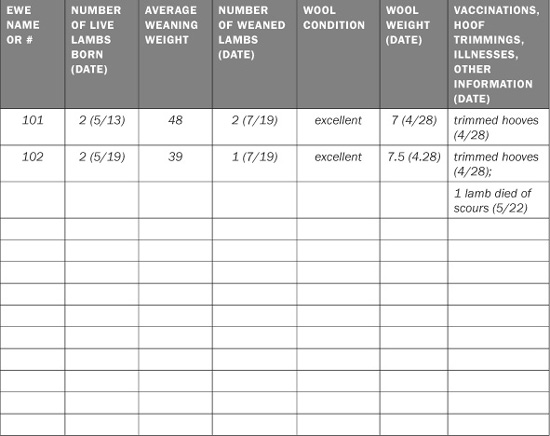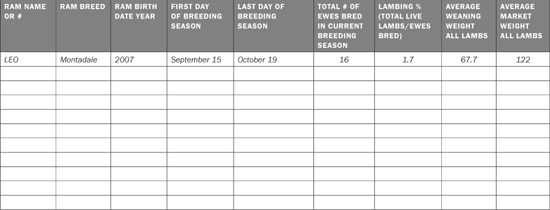
THE TIMES HAVE CHANGED. When Ken and I first started raising livestock, all our records consisted of notes jotted onto a calendar and into a three-ring binder. Today our records are kept on computers. Both systems worked, but there is no doubt that we are able to capture more information, and more meaningful information, on the computer. No matter how you keep records, they are important. Your records will help you make culling and breeding decisions. They can be a valuable tool if you market breeding stock. And they can serve as a history of your flock.
Record keeping starts with individual animal identification. A simple record would include a name or identifying number, the birth date or acquisition date if the stock was purchased from another farm, sex, type of birth (single, twins, triplets), and general husbandry records (such as information on vaccinations). The next step is to capture more-detailed breeding information, such as information on the animal’s dam and sire. To improve management you can add more-detailed data on performance, such as individual weaning weights of lambs born to a ewe or out of a ram’s “get” (offspring), as well as postweaning growth measures, such as 120-day weight.
Many purebred sheep breeders participate in the National Sheep Improvement Program (NSIP). NSIP, which is designed to help purebred sheep producers identify the best genetic stock for their breeding program, uses computerized, performance-based selection criteria for things such as growth rate, percent lamb crops, and grease-wool production. Based on records that are entered into a computer program, the shepherd receives reports that detail “Expected Progeny Differences” (EPDs) for different animals. The EPD process has been used extensively in the dairy, beef cattle, and swine industries for many years and is only now being implemented in the sheep industry.
NSIP works through the breed associations or with groups of producers to deliver across-flock EPDs to purebred breeders, who then use these EPDs to guide them in their selection and genetic-improvement programs. A producer who is a member of NSIP receives reports on the EPD values (reported as plus or minus numbers from the breed’s average) for every animal in a flock, based on the actual performance of the animals according to the shepherd’s records and also based on all the animals that are genetically related to them. Data are tracked over many years and many management systems, which increases the efficiency and reliability of the data. EPDs essentially rank all the animals by certain genetic values, which helps the shepherd identify high-producing replacements, cull poor-producing animals, and improve certain genetic traits by pairing rams and ewes that will move the flock in the direction the shepherd wants.
With a home computer, you can use spreadsheets (such as Excel and Lotus) to create records. There are templates for spreadsheets available from a variety of sites on the Internet that let you balance rations and track flock records, but truly, today there are such great software options that are relatively inexpensive (anywhere from about $50 to $300) that I strongly recommend using software.
At least a dozen companies provide software that makes tracking flock information a snap. These systems include basic animal ID, but they also provide detailed health and medical records, ration balancing, marketing-related records (such as dairy, meat-quality, and wool-quality records), and complete financial records. These programs are easy to use and will pay for themselves fairly quickly. Several work with handheld devices, such as a “Palm” device, making them ideal for recording data in the barn or field. Most of the companies that produce software have free download trials, so you can actually play with a few before settling on a product. Susan Schoenian has a list of software programs on her Web site (see Resources for her Web address).
If you want to avoid computers, or if you want to set up your own record system on a spreadsheet, here are a few samples to give you an idea:

